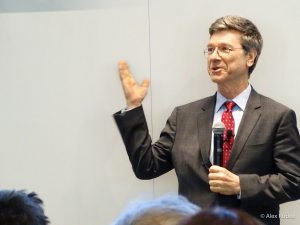
On Friday, the “Biodiversity Days” conference hosted by the E.O. Wilson Foundation wrapped up at the Nicholas School. It was a two-day whirlwind of renowned speakers, invigorating discussion and inspiring stories about protecting life on Earth. My fellow blogger Jill posted a great recap of the featured evening lecture by renowned biologist E.O. Wilson himself, which also starred Wilson’s friend Paul Simon and the most bone-chilling rendition of “Sounds of Silence” I’ve ever heard.
But for me, the most inspiring and urgent messages of the conference came the next day. It was then that I came to see the conference’s central theme – protecting half of the planet for species besides our own – as not just a scientific or moral imperative, but a patriotic duty.
As veteran New York Times columnist Thomas Friedman put it during his lecture, “green is the new red, white and blue.”

The twin problems of climate change and biodiversity loss are no longer just environmental issues, Friedman explained. They’re human rights issues and national security issues, too.
Increasing water scarcity, record heat waves and worsening soil quality in places like West Africa and the Middle East are now making traditional lifestyles impossible. The only option left: migration.
These climate refugees are fueling the European migrant crisis that has threatened the stability of the EU and is quickly becoming a flash point in American politics. And unless we act quickly to reduce carbon emissions and protect forests and grasslands around the world, which are rich in both carbon and biodiversity, the problem will only get worse.
“It makes no sense to have an immigration policy,” Friedman asserted, “without a climate policy.”
So what can we do?
Friedman rattled off a checklist: Register a new voter before the next election. Pick up the phone and make sure your elected officials know that conservation is important to you. And finally, run for office yourself.
It was a bold call to action. And it’s one that the next speaker, Mike Phillips, spoke on from personal experience.
Phillips is the executive director of the Turner Endangered Species Fund and a career conservation biologist. He spent most of his lecture detailing the fund’s work reintroducing Mexican wolves, desert bighorn sheep and other species onto American landscapes. But at the end, just when I expected him to start Q&A, Phillips instead launched into his own personal story.
He explained how his work in conservation had convinced him of the urgency of political action. Overcoming his aversion to politics as a natural scientist, Philipps decided to run for the Montana state legislature in 2004. He campaigned hard – and lost.
Two years later, however, he won a seat in the state House. Phillips has now served in Montana’s legislature for over a decade, pushing legislation to combat climate change and protect biodiversity. But it hasn’t been easy.
“All too often, politics trumps science,” Phillips said sadly.
The solution? More scientists in elected office. “Electoral politics is extremely well-suited to people like us,” Phillips said. “It’s all about debate, and it rewards people that show up.”

The message was clear: we in the conservation community need to take more time out from our academic journals and put more time into legislative offices, whether as legislators ourselves or, at least, as concerned and politically-active constituents.
The stakes for action are incredibly high. At the closing session for Biodiversity Days, Columbia economist Jeffrey Sachs reminded the packed auditorium that the U.S. is the only nation on Earth that hasn’t ratified the UN Convention on Biological Diversity.
“We are losing badly,” Sachs said, referring to efforts to build support for biodiversity conservation nationally and globally. If we don’t build a political movement, we can’t expect governments to act of their own accord.
“The message can’t be just that biodiversity is important,” Sachs concluded. “We have to tell policymakers what to do.”
I’ve got one idea: maybe next year, we should tell our elected officials to come to Biodiversity Days.
